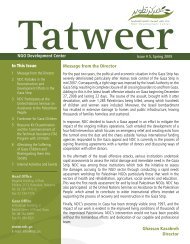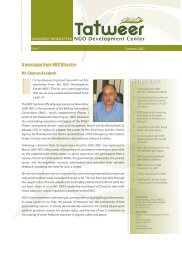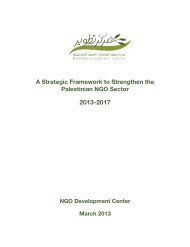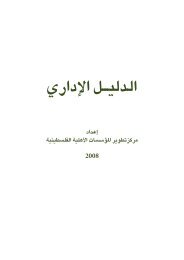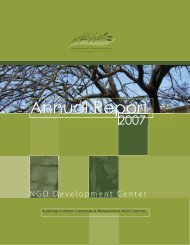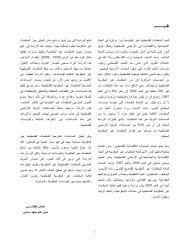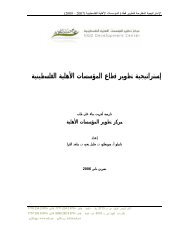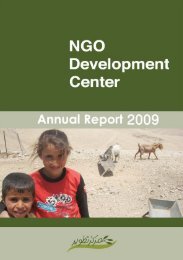Tracking External Donor Funding.pdf - NDC
Tracking External Donor Funding.pdf - NDC
Tracking External Donor Funding.pdf - NDC
You also want an ePaper? Increase the reach of your titles
YUMPU automatically turns print PDFs into web optimized ePapers that Google loves.
Year<br />
# of NGOs<br />
Returning<br />
data<br />
Table 3: PNGO Survey Results versus Estimated Aid to PNGOs<br />
% of Total<br />
NGOs<br />
Surveyed<br />
Total Amount<br />
Surveyed (USD)<br />
PNGOs<br />
MoP Estimate<br />
of Total Aid to<br />
PNGOs<br />
% MoP<br />
Estimate<br />
Surveyed<br />
Est’d total<br />
Ext’l Aid to<br />
PNGOs (MAS)<br />
% of MAS<br />
Estimates<br />
Surveyed<br />
1999 41 51 39,000,000 48,000,000 82 53,000,000 74<br />
2000 24 30 20,000,000 55,000,000 37<br />
2001 27 34 28,000,000 93,000,000 31<br />
2002 31 39 36,000,000 103,000,000 35<br />
2003 37 46 31,000,000 65,000,000 47<br />
2004 44 55 42,000,000 57,000,000 74<br />
2005 61 76 55,000,000 218,000,000 27<br />
2006 80 100 121,000,000 196,000,000 62 136,000,000 89<br />
2007 78 98 147,000,000 213,000,000 69<br />
2008 78 98 126,000,000 258,000,000 49<br />
Total <strong>Funding</strong> Captured 645,000,000<br />
Note: Estimates to the nearest million and percentages to the nearest whole number.<br />
PNGO Survey Sample Analysis<br />
A key point discussed in our PNGO survey Focus<br />
Group 4 , was the fact that our PNGO sample does not<br />
offer a representative picture of PNGO activities in terms<br />
of sector, geography and target population. However, the<br />
survey of less than five percent of the estimated number<br />
of PNGOs did not aim to map these institutions. Instead<br />
we aimed to track the activities of donors and primarily<br />
the activities of the largest PNGOs, who are also the<br />
largest recipients of external aid, in terms of the sector,<br />
geography and target of their work. The following<br />
sections highlight some of the characteristics of our<br />
sample.<br />
Scope of Work<br />
33 of the 80 PNGOs we surveyed (41%) work at the<br />
national level and provide services throughout both the<br />
West Bank and Gaza Strip. 19 respondent PNGOs (24%)<br />
claimed to work throughout the West Bank only and 16<br />
(20%) claimed to work throughout the Gaza Strip only.<br />
Finally, 11 PNGOs claimed to work at the district or<br />
governorate level and only one PNGO’s activities<br />
remained at the individual community level. 54 of the 80<br />
PNGOs surveyed (68%) had established branch offices<br />
to extend the scope of their services.<br />
Besides the actual budgets of those sampled, this is the<br />
best indication that our survey is weighted heavily<br />
towards large PNGOs. According to the 2007 MAS<br />
Mappings, only 11% of PNGOs worked at the national<br />
level, 8.1% at the level of the West Bank and 12.4%<br />
throughout all of the Gaza Strip. Whereas only one<br />
surveyed PNGO worked at the local level, in 2007 31.9%<br />
of all PNGOs did so.<br />
Sector Groupings of PNGO Sample<br />
As the limited PNGO survey sample worked to track<br />
trends in external aid as opposed to PNGO activities, the<br />
19 sectors were divided into 5 groups, in order to have a<br />
broader picture of international donor activities. Table 4<br />
shows the distribution of sectors into groupings.<br />
Table 5 shows the distribution of our sample by sector,<br />
grouping and region. As our intention was to capture as<br />
much of the external aid as possible within the scope of<br />
our sample, some figures stands out clearly.<br />
18 of the 80 PNGOs surveyed were focused on rightsbased<br />
development and located in the Central West Bank<br />
(C WB). 10 of the Economic based PNGOs and 5 of the<br />
Education-based PNGOs were also from the C WB. The<br />
reason for this over representation will become clear<br />
throughout the study, but it is worth mentioning now.<br />
When tracking external donor funding to PNGOs, as<br />
opposed to mapping PNGO activity, a small targeted<br />
sample is capable of capturing the bigger picture; but<br />
only if one is to recognize the existing geographic and<br />
sectoral inequalities of aid to PNGOs, rather than attempt<br />
to build a sample representative of PNGOs themselves.<br />
While our survey of 1,388 PNGOs in 2006 yielded an<br />
estimate of nearly 136 million USD in external aid to the<br />
sector; our sample shows that almost 90% of it is<br />
captured by only 80 organizations.<br />
4<br />
The PNGO Survey workshop was held at MAS on October 26 th ,<br />
2009,<br />
4


